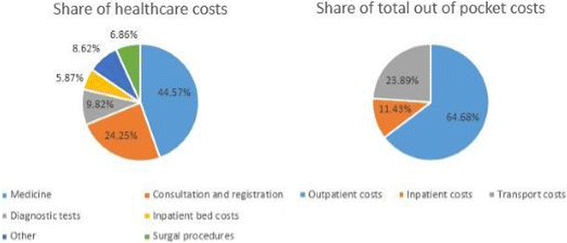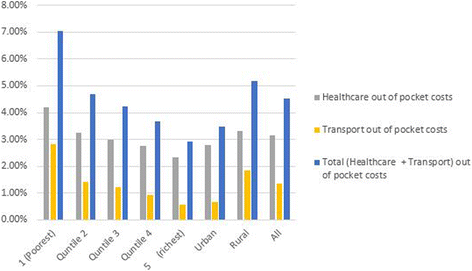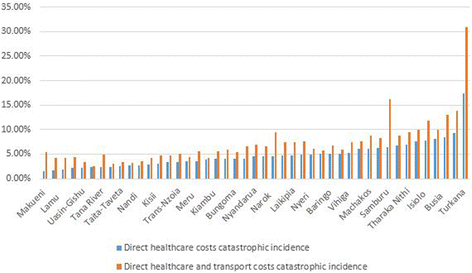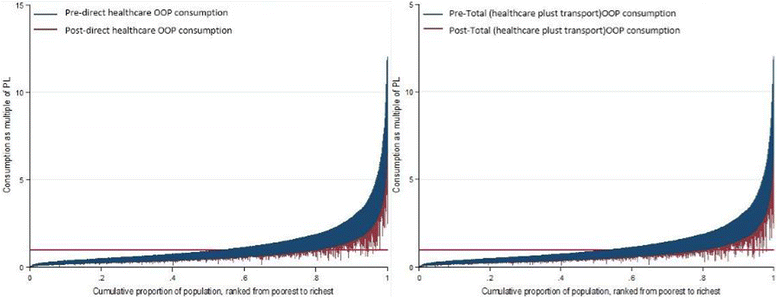Assessing the impoverishing effects, and factors associated with the incidence of catastrophic health care payments in Kenya
- PMID: 28166779
- PMCID: PMC5294805
- DOI: 10.1186/s12939-017-0526-x
Assessing the impoverishing effects, and factors associated with the incidence of catastrophic health care payments in Kenya
Abstract
Background: Monitoring the incidence and intensity of catastrophic health expenditure, as well as the impoverishing effects of out of pocket costs to access healthcare, is a key part of benchmarking Kenya's progress towards reducing the financial burden that households experience when accessing healthcare.
Methods: The study relies on data from the nationally-representative Kenya Household Expenditure and Utilization Survey conducted in 2013 (n =33,675). We undertook health equity analysis to estimate the incidence and intensity of catastrophic expenditure. Households were considered to have incurred catastrophic expenditures if their annual out of-pocket health expenditures exceeded 40% of their annual non-food expenditure. We assessed the impoverishing effects of out of pocket payments using the Kenya national poverty line. We distinguished between direct payments for healthcare such as payments for consultation, medicines, medical procedures, and total healthcare expenditure that includes direct healthcare payments and the cost of transportation to and from health facilities. We used logistic regression analysis to explore the factors associated with the incidence of catastrophic expenditures.
Results: When only direct payments to healthcare providers were considered, the incidence of catastrophic expenditures was 4.52%. When transport costs are included, the incidence of catastrophic expenditure increased to 6.58%. 453,470 Kenyans are pushed into poverty annually as a result of direct payments for healthcare. When the cost of transport is included, that number increases by more than one third to 619,541. Unemployment of the household head, presence of an elderly person, a person with a chronic ailment, a large household size, lower household social-economic status, and residence in marginalized regions of the country are significantly associated with increased odds of incurring catastrophic expenditures.
Conclusions: Kenyan policy makers should prioritize extending pre-payment mechanisms to more vulnerable groups, specifically the poor, the elderly, those suffering from chronic ailments and those living in marginalized regions of the country. The range of services covered under these mechanisms should also be extended such that the proportion of direct costs paid to access care is reduced. Policy makers should also prioritize reducing supply side bottlenecks such as availability of healthcare facilities in close proximity to the population, especially in rural and marginalized areas, and improvements in quality of care. For the poor and the vulnerable, initiatives to cover the cost of transport to and from a health facility, such as transport vouchers could also be explored.
Keywords: Catastrophic health spending; Financial risk protection; Household health spending; Kenya; Out of pocket health spending.
Figures
Similar articles
-
Examining the incidence of catastrophic health expenditures and its determinants using multilevel logistic regression in Malawi.PLoS One. 2021 Mar 31;16(3):e0248752. doi: 10.1371/journal.pone.0248752. eCollection 2021. PLoS One. 2021. PMID: 33788900 Free PMC article.
-
Catastrophic health care spending and impoverishment in Kenya.BMC Health Serv Res. 2012 Nov 21;12:413. doi: 10.1186/1472-6963-12-413. BMC Health Serv Res. 2012. PMID: 23170770 Free PMC article.
-
Out-of-Pocket Payments, Catastrophic Health Expenditure and Poverty Among Households in Nigeria 2010.Int J Health Policy Manag. 2018 Sep 1;7(9):798-806. doi: 10.15171/ijhpm.2018.19. Int J Health Policy Manag. 2018. PMID: 30316228 Free PMC article.
-
Economic Burden of Chronic Ill Health and Injuries for Households in Low- and Middle-Income Countries.In: Jamison DT, Gelband H, Horton S, Jha P, Laxminarayan R, Mock CN, Nugent R, editors. Disease Control Priorities: Improving Health and Reducing Poverty. 3rd edition. Washington (DC): The International Bank for Reconstruction and Development / The World Bank; 2017 Nov 27. Chapter 6. In: Jamison DT, Gelband H, Horton S, Jha P, Laxminarayan R, Mock CN, Nugent R, editors. Disease Control Priorities: Improving Health and Reducing Poverty. 3rd edition. Washington (DC): The International Bank for Reconstruction and Development / The World Bank; 2017 Nov 27. Chapter 6. PMID: 30212160 Free Books & Documents. Review.
-
Action to address the household economic burden of non-communicable diseases.Lancet. 2018 May 19;391(10134):2047-2058. doi: 10.1016/S0140-6736(18)30323-4. Epub 2018 Apr 5. Lancet. 2018. PMID: 29627161 Review.
Cited by
-
"It is like an umbrella covering you, yet it does not protect you from the rain": a mixed methods study of insurance affordability, coverage, and financial protection in rural western Kenya.Int J Equity Health. 2023 Feb 6;22(1):27. doi: 10.1186/s12939-023-01837-2. Int J Equity Health. 2023. PMID: 36747182 Free PMC article.
-
Financial Toxicity Among Patients With Breast Cancer Worldwide: A Systematic Review and Meta-analysis.JAMA Netw Open. 2023 Feb 1;6(2):e2255388. doi: 10.1001/jamanetworkopen.2022.55388. JAMA Netw Open. 2023. PMID: 36753274 Free PMC article.
-
Exploring dynamics in catastrophic health care expenditure in Nigeria.Health Econ Rev. 2022 Mar 23;12(1):22. doi: 10.1186/s13561-022-00366-y. Health Econ Rev. 2022. PMID: 35322315 Free PMC article.
-
Examining health facility financing in Kenya in the context of devolution.BMC Health Serv Res. 2021 Oct 13;21(1):1086. doi: 10.1186/s12913-021-07123-7. BMC Health Serv Res. 2021. PMID: 34645443 Free PMC article.
-
Catastrophic health expenditure and the risk of depression among middle-aged and old people in China: a national population-based longitudinal study.Epidemiol Psychiatr Sci. 2023 May 17;32:e36. doi: 10.1017/S2045796023000240. Epidemiol Psychiatr Sci. 2023. PMID: 37194279 Free PMC article.
References
-
- United Nations. Sustainable develoment goals: 17 goals to transform our world. 2015. [Online]. Available: http://www.un.org/sustainabledevelopment/. Accessed: 25 Mar 2016.
-
- WHO. Resolution on health financing: A strategy for the African Region. Geneva: World Health Organization; 2006.
Publication types
MeSH terms
Grants and funding
LinkOut - more resources
Full Text Sources
Other Literature Sources





